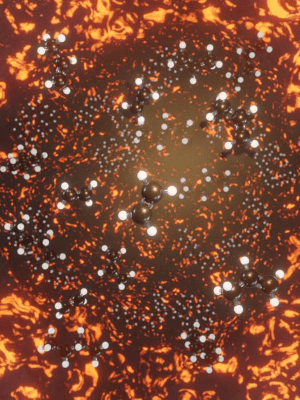
Unlike glass, which is infinitely recyclable (well okay, maybe not exactly), plastic is challenging and expensive to recycle because of the material’s complex molecular structure designed for specific needs.
A recent project appears to advance understanding of what happens to plastic during pyrolysis, and gives a sense of the challenges and possibilities inherent in this approach to plastic recycling. It recently featured on the cover of the American Chemical Society (ACS) Journal of Chemical Theory and Computation.
“Pyrolysis is relatively low in cost and can generate high-value products, so it presents an appealing, practical solution,” said Giannis Mpourmpakis, leader of a recent study at the University of Pittsburgh. “It has already been developed on a commercial scale. The main challenge now is finding optimal operating conditions, given the starting and final chemical products, without needing to rely heavily on trial-and-error experimentation.”
To optimize pyrolysis conditions and produce desired products, researchers typically use thermodynamic calculations based on what’s known as the Gibbs free energy minimization approach. However, the lack of thermochemical data can limit the accuracy of these calculations.
While density functional theory (DFT) calculations are commonly used to obtain precise thermochemical data for small molecules, their application becomes challenging and computationally expensive for the large, flexible molecules that make up waste plastics, especially at elevated temperatures of pyrolysis.
In this study, Mpourmpakis and former postdoc Hyunguk Kwon developed a computational framework to accurately calculate the temperature-dependent thermochemistry of large and flexible molecules. This framework combines conformational search, DFT calculations, thermochemical corrections, and Boltzmann statistics; the resulting thermochemistry data is used to predict the thermal decomposition profiles of octadecane, a model compound representing polyethylene.
The proposed computational analysis based on first principles offers a significant advancement in predicting temperature-dependent product distributions from plastic pyrolysis. It can guide future experimental efforts in chemical plastic recycling, enabling researchers to optimize pyrolysis conditions and increase the efficiency of converting waste plastics into valuable chemicals.
“The production of plastics is expected to keep increasing, so it’s essential that we find and perfect ways to recycle and reuse plastics without harming the environment,” said Mpourmpakis. “This work, which has been funded by the National Science Foundation, contributes to the development of sustainable waste management strategies and the reduction of plastic pollution, offering potential benefits for both the environment and society.”
The paper, “Ab Initio Thermochemistry of Highly Flexible Molecules for thermal Decomposition Analysis,” (DOI: 10.1021/acs.jctc.3c00265), was featured on the cover of the June 23, 2023 issue of the Journal of Chemical Theory and Computation.






